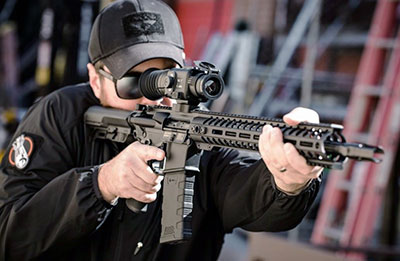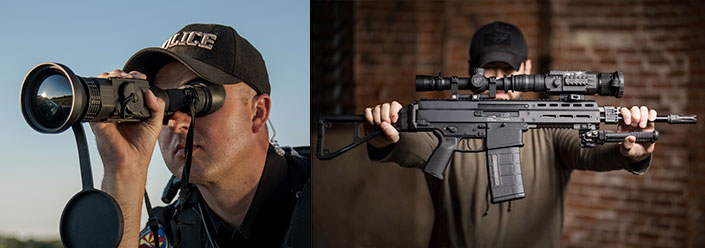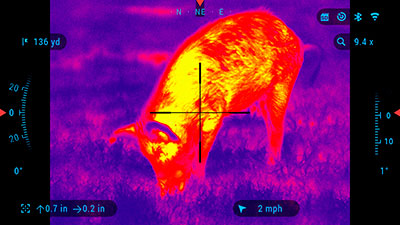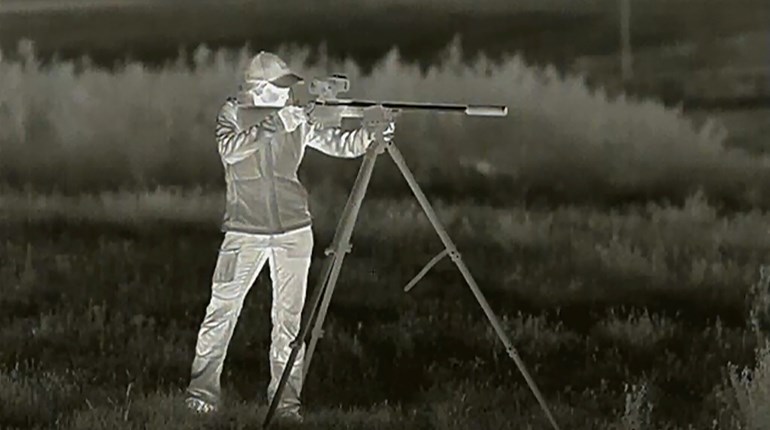
For the past 10 years, a bunch of straight-shooting roughnecks from Colorado, New Hampshire, Arizona and California have been targeting feral hogs each spring somewhere special in South Texas. As a defense industry exec focused on advanced warfighter aiming and illumination technology, I’ve coached these hunters along the technology curve. The hog, coyote, bobcat, raccoon and jackrabbit body counts have significantly increased each year as the group embraces advanced night-vision technology and works on marksmanship with MSRs and bolt guns.
Unfortunately for the critters, our team has transitioned from rifle-mounted LED flashlights to image-intensified night vision and now through several generations of cell-phone thermal imagers, hand-held thermal imagers and thermal weapon sights. As the group’s night-vision technology improved, so did the range of engagements, the accuracy of our shots, the quickness of follow-up shots, the richness of our harvest and the magnitude of our barbecues.

What are thermal imagers and weapon sights?
Hand-held, head-mounted or weapon-mounted thermal scopes and binoculars are advanced electro-optical imaging tools that allow users to quickly and clearly identify targets in a field, at sea, in the woods or in an urban environment during zero-light, low-light, bright-light or weather-obscured conditions. Thermal sights can locate and identify targets because people, vehicles and animals together with all non-absolute zero objects generate some heat (emit photons).
They have been used extensively by the U.S. military during the Global War on Terrorism. The original DoD Thermal Weapon Sight Program saw 200,000 infrared weapon sights fielded to help M4/M16, crew-served weapons and sniper rifles maximize their effectiveness under duress and in absolute darkness. These three TWS models featured a wide, medium and narrow fields-of-view (FOV) with corresponding 30 mm (individual), 50 mm (crew served) and 100 mm (sniper and crew served) lenses. Thermal weapon sights helped our troops “own the night” during the war. They can now help you do the same on your night hunts or defend your home and hearth.
How do thermal cameras work?
Most things on earth absorb and emit some level of electromagnetic radiation (heat), even rocks that are heated by the sun and then cool in the shade. Living things, like people, emit enormous amounts of this energy because we are warm blooded. The difference between the heat we emit and that of a cold car engine are easy to measure with thermal-camera technology.
Heat, or electromagnetic radiation, consists of photons that travel through the air in waves. A portion of these waves travel in the infrared portion of the electromagnetic spectrum. Most thermal sights contain a sensor, called an uncooled micro-bolometer, which detects those waves of photons traveling in the long-wave portion (8 to 12 microns) of the electromagnetic spectrum. The detector then converts the photons to electronic signals.
These signals relate to the amount of energy which is related to the temperature of the various objects that we are viewing/photographing. Since the cold car, the rock, a tree and a wild boar all emit heat at different intensities, the IR detector creates different signals for the differing objects. A signal is registered for each .1 degree Celsius, or 1/10th of a degree Celsius, meaning 10 differing signals for every single degree Celsius. These different signals are then converted to shades of gray or color, and then get rendered into images by the sensor. These images then get displayed on an organic LED screen (OLED), which is like a mini-TV screen inside the scope. Detectors have different sizes and sensitivities, just as cars have different engine displacements and horsepower.
Once the processed signals reach the micro-OLED, the user then can see the magnified image through an optical eyepiece or even through an existing day optic if the thermal sight is configured as a clip-on sight (aka “in-line” sight). The thermal engine refreshes the signals, the faster the refresh rate, the easier it is to smoothly track a target.
IR Camera Optics
Infrared lenses focus captured infrared radiation (photons) in the 8- to 12-micron wavelength, or Long Wave portion of the Infrared Spectrum, onto the detector just as your glasses focus light onto your pupil. Note: Visible light will not pass through these lenses as it travels in a different wavelength.
Magnification and Zoom
Like regular cameras and scopes, thermal weapon sights come with different powers of optical magnification (e.g. 1X, 3X, etc.) and manufacturers often equip the systems with digital zooms, usually up to 8X. (Note: The image quality will degrade as you digitally magnify them. Your 640x488 µm detector delivers a 320x244 µm resolution image with the 2X digital zoom engaged and a 160x122 µm resolution at 4X and 80x60 µm at 8X magnification.)
For wildlife observation, the 320, 384- and 640-pixel array detectors with 17 µm pixel pitch (the distance from the center of one pixel to the next, measured in microns) should be adequate within 200 to 300 yards. You’ll get more detailed image information with the greater number of pixels offered by the 640, but I’ve personally used both 320 and 384 detectors in my thermal scopes and gotten the job done. However, if I were a cop, a soldier, working in search and rescue or acting as an armed home defender dealing with two-legged threats, I would want the extra info delivered by a 640x488 (or 640x512 µm).
As to 12 µm-pp or 10 µm-pp detectors, they are more compact, cheaper to produce and display great imagery, but they require faster (usually larger and more expensive) lenses to absorb as much energy as the larger pixel devices. In any case, 17 µm pp on a 320- or 384-detector with a 30/35 mm-effective focal length (EFL) lens assembly is completely adequate for identifying and targeting objects within 200 to 300 yards and, with a 19 mm lens, 100- to 150-yard shots should be no problem. The larger the number of pixels in a focal-plane array the more energy is captured resulting in a more precisely rendered image.
One of the reasons thermal weapon sights (TWS) and thermal monoculars/binoculars are becoming popular with people in the military and civilians alike is that they are sensitive to minute differences in temperature. This permits the detection of a live person (98.6 degrees Fahrenheit), an animal or an operating vehicle very easy to distinguish from non-living objects, which are usually much closer to ambient temperatures.
Modern thermal cameras create very crisp images due to the ability to distinguish among each object’s temperature. If someone places a hand on a table, you will be able to see a residual heat signature on the table (once the hand is removed) using a thermal camera.

Military Usage
Military contractors such as BAE Systems, Raytheon Technologies, FLIR, DRS, Trijicon and Meprolight produce a variety of high-quality, hand-held, helmet- and weapon-mounted thermal cameras. These are quite rugged and can operate from -40 degrees Celsius to +65 degrees Celsius, are usually submersible to 66 feet and can operate at high altitudes as well. Tens of thousands of 320x240 17 µm and 384x288 17 µm pp units are currently in use on battlefields and improved 640x480 17 µm and 12 µm pp units are being rolled out as you read this.
The weapon sights come as Light, Medium and Heavy variants with 30 mm, 50 mm and 100 mm lens options. These get mounted on weapon systems from the M4 rifle to the Squad Automatic Weapon (SAW) all the way to the Browning .50-caliber machine gun (Ma Deuce). Military LWIR thermal cameras rarely cost less than $10,000 to $15,000, often quite a bit more.
Features
Newer model thermal cameras, like standard visible cameras, now have removable data storage card slots, video-out ports, Wi-Fi (to your phone), Bluetooth (to your phone), still-image and video-capture capabilities. They also have time and date stamps, algorithmic range-finders, laser range-finder attachments, compass, attitude meters and more. This allows operators to capture mission imagery and data for analysis, to share real time or to download for later.
Additionally, zeros can be saved for different loads. Thermal cameras additionally allow the image to be adjusted from a color palette ranging from black hot, white hot, to a custom variety of colors. Essentially, they have wide capabilities to customize the imagery to best help you detect, recognize, identify and nail your quarry. Expect to pay more for additional features.

Zeroing
Thermal sights typically offer a variety of reticles for precise aiming and are quite easy to zero with a single shot. Scroll through the menu to reticle options and click through until you find the reticle you want to use, then save it.
Then cycle through the menu to the zeroing options. Take your shot from an immobile rest. Then, push the menu button and scroll to the zero menu. Enter the reticle zero menu. Hold the dot on the point-of-aim. Adjust the center of the reticle, click by click, to the point of your round’s impact. Press save and voila, the sight is zeroed. I usually send a confirmation shot just to feel confident. Do this at the range at which you normally zero, or if struggling, first get it dialed in at 25 or 50 yards and then take it to 100. Several manufacturers allow you to save multiple zeros, say for different rifles or different loads.
I recommend using a chemical hand warmer tacked to your target, blow torching steel, or painting steel black or white (both colors distinguish themselves from ambient temperature in the sun), as the zero focal point. This gives you a nice target to aim at. Cold or hot drinks are nice too. Black or white paper plates as well as shiny pie plates or shiny party bags from the Dollar store work, too. Have fun trying different things.
As with all electronics, the greater the number of features, the higher the price. Thanks to Moore’s law, though, the price of the electronics and processing power is now plummeting at a fantastic rate.

One hundred to 200 yards: Investigate thermal weapon sights outfitted with a minimum 19 mm-focal length lens (50 mm is preferable if you have the money). A rugged and reliable 17 micron 384x288 TWS with a 19 mm EFL lens will set you back about $2,000. You should be purposefully lethal within 100 to 150 yards.
In excess of 200 yards: If your budget allows, a 12 µm 640x488 sight with a 75 mm or 100 mm EFL lens. These big-dollar setups will run very close to $7,000 to $10,000 and up, but you will own the night near, and far, with this type of system, out to 500 yards or more. Hand-held or head-mounted: 19 mm to 35 mm effective focal length is perfect.
To significantly improve your nighttime marksmanship the first thing to do is make sure your equipment is in good and safe working order, that your ammunition is in good shape and that you have a safe place to shoot. Follow the four cardinal firearm-safety rules.
Second, practice your marksmanship skills as if your life, your family and your country depend upon them. Ideally, every rifleman and riflewoman should be able to safely and consistently hit 2- to 3-inch round or square targets from standing, sitting, kneeling and prone positions from 100 yards, then 200 yards and beyond in all kinds of weather and light conditions.
Third, go night shooting with some buddies who already have night vision and thermal imaging gear. Try out several combinations of optics until you find one with which you are successful, and which you can get past your spouse.
Good news, prices are dropping fast. You do not need to spend $5,000 or $10,000 anymore. I am having good success with a sub $3,000 384x488 thermal scope with a 50 mm lens assembly. Good luck and straight shooting at night.
About the Author: Devin Standard is a defense-industry veteran specializing in advanced warfighter aiming and illumination technology. He is also an NRA-certified firearms instructor.






































